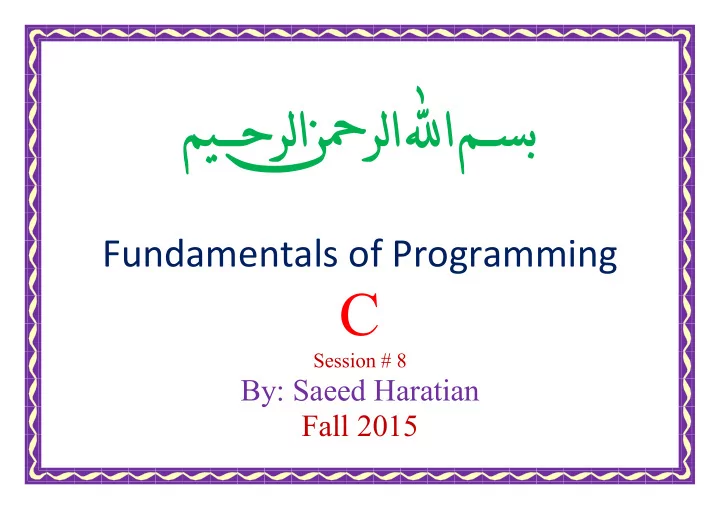

Fundamentals of Programming C Session # 8 By: Saeed Haratian Fall 2015
Outlines Counter-Controlled Repetition Sentinel-Controlled Repetition Top-Down, Stepwise Refinement
Counter-Controlled Repetition Consider the following problem statement : A class of ten students took a quiz. The grades (integers in the range 0 to 100) for this quiz are available to you. Determine the class average on the quiz. This technique uses a variable called a counter to specify the number of times a set of statements should execute.
Counter-Controlled Repetition … The Pseudocode is :
Counter-Controlled Repetition …
Counter-Controlled Repetition …
Counter-Controlled Repetition … Variables used to store totals should normally be initialized to zero before being used in a program; otherwise the sum would include the previous value stored in the total’s memory location. Counter variables are normally initialized to zero or one, depending on their use (we’ll present examples showing each of these uses). An uninitialized variable contains a “garbage” value— the value last stored in the memory location reserved for that variable.
Counter-Controlled Repetition …
Sentinel-Controlled Repetition Let’s generalize the class average problem. Consider the following problem: Develop a class averaging program that will process an arbitrary number of grades each time the program is run. How can the program determine when to stop the input of grades? How will it know when to calculate and print the class average?
Sentinel-Controlled Repetition … One way to solve this problem is to use a special value called a sentinel value (also called a signal value, a dummy value, or a flag value) to indicate “end of data entry.” The user types in grades until all legitimate grades have been entered. The user then types the sentinel value to indicate that the last grade has been entered. Clearly, the sentinel value must be chosen so that it cannot be confused with an acceptable input value.
Top-Down, Stepwise Refinement We approach the class average program with a technique called top-down, stepwise refinement, a technique that is essential to the development of well- structured programs. We begin with a pseudocode representation of the top: Determine the class average for the quiz The top is a single statement that conveys the program’s overall function. As such, the top is, in effect, a complete representation of a program.
Top-Down, Stepwise Refinement … Unfortunately, the top rarely conveys a sufficient amount of detail for writing the C program. We divide the top into a series of smaller tasks and list these in the order in which they need to be performed. This results in the following first refinement. Initialize variables Input, sum, and count the quiz grades Calculate and print the class average Here, only the sequence structure has been used—the steps listed are to be executed one after the other.
Top-Down, Stepwise Refinement … To proceed to the next level of refinement, i.e., the second refinement, we commit to specific variables. We need a running total of the numbers, a counter of how many numbers have been processed, a variable to receive the value of each grade as its input and a variable to hold the calculated average. The first pseudocode statement may be refined as follows: Initialize total to zero Initialize counter to zero
Top-Down, Stepwise Refinement … The pseudocode statement requires a repetition structure (a loop) that successively inputs each grade. Since we do not know how many grades are to be processed, we’ll use sentinel-controlled repetition. Input the first grade While the user has not entered the sentinel Add this grade into the running total Add one to the grade counter Input the next grade (possibly the sentinel)
Top-Down, Stepwise Refinement … The last pseudocode statement may be refined as : if the counter is not equal to zero set the average to the total divided by the counter print the average else print “No grades were entered” Notice that we’re being careful here to test for the possibility of division by zero—a fatal error that if undetected would cause the program to fail (often called “bombing” or “crashing”).
Top-Down, Stepwise Refinement …
Top-Down, Stepwise Refinement …
Top-Down, Stepwise Refinement …
Top-Down, Stepwise Refinement …
Top-Down, Stepwise Refinement …
Cast operator Dividing two integers results in integer division in which any fractional part of the calculation is lost (i.e., truncated). Since the calculation is performed first, the fractional part is lost before the result is assigned to average. To produce a floating-point calculation with integer values, we must create temporary values that are floating-point numbers. C provides the unary cast operator to accomplish this task.
Cast Operator … Cast operators are available for most data types. The cast operator is formed by placing parentheses around a data type name. The cast operator is a unary operator, i.e., an operator that takes only one operand. Cast operators associate from right to left and have the same precedence as other unary operators such as unary + and unary -. This precedence is one level higher than that of the multiplicative operators *, / and %.
Precision specifier Figure 3.8 uses the pr i nt f conversion specifier %.2f (line 41) to print the value of average. The .2 is the precision with which the value will be displayed—with 2 digits to the right of the decimal point. If the %f conversion specifier is used, the default precision of 6 is used—exactly as %.6f had been used. When floating-point values are printed with precision, the printed value is rounded to the indicated number of decimal positions.
Any Question ?
Recommend
More recommend